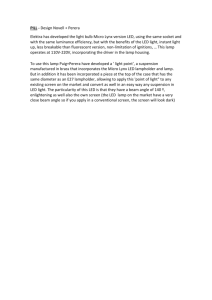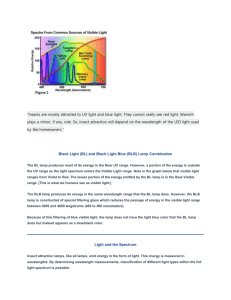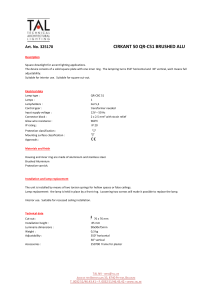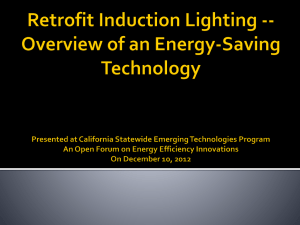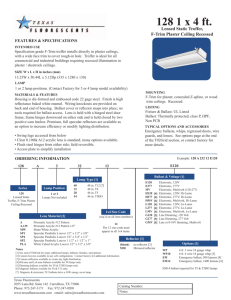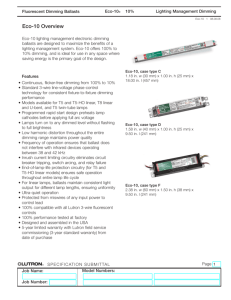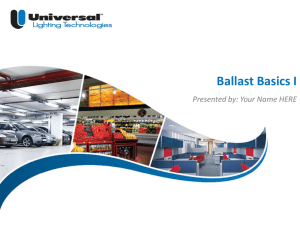Going… GREEN…
advertisement
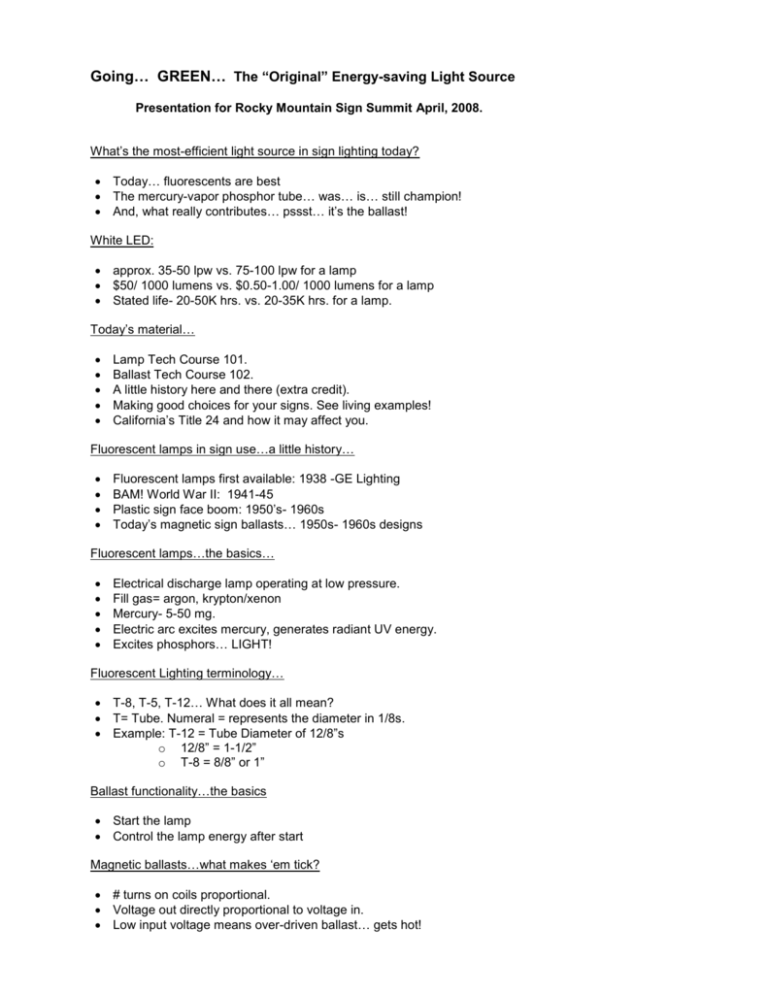
Going… GREEN… The “Original” Energy-saving Light Source Presentation for Rocky Mountain Sign Summit April, 2008. What’s the most-efficient light source in sign lighting today? Today… fluorescents are best The mercury-vapor phosphor tube… was… is… still champion! And, what really contributes… pssst… it’s the ballast! White LED: approx. 35-50 lpw vs. 75-100 lpw for a lamp $50/ 1000 lumens vs. $0.50-1.00/ 1000 lumens for a lamp Stated life- 20-50K hrs. vs. 20-35K hrs. for a lamp. Today’s material… Lamp Tech Course 101. Ballast Tech Course 102. A little history here and there (extra credit). Making good choices for your signs. See living examples! California’s Title 24 and how it may affect you. Fluorescent lamps in sign use…a little history… Fluorescent lamps first available: 1938 -GE Lighting BAM! World War II: 1941-45 Plastic sign face boom: 1950’s- 1960s Today’s magnetic sign ballasts… 1950s- 1960s designs Fluorescent lamps…the basics… Electrical discharge lamp operating at low pressure. Fill gas= argon, krypton/xenon Mercury- 5-50 mg. Electric arc excites mercury, generates radiant UV energy. Excites phosphors… LIGHT! Fluorescent Lighting terminology… T-8, T-5, T-12… What does it all mean? T= Tube. Numeral = represents the diameter in 1/8s. Example: T-12 = Tube Diameter of 12/8”s o 12/8” = 1-1/2” o T-8 = 8/8” or 1” Ballast functionality…the basics Start the lamp Control the lamp energy after start Magnetic ballasts…what makes ‘em tick? # turns on coils proportional. Voltage out directly proportional to voltage in. Low input voltage means over-driven ballast… gets hot! Electronic ballasts…what makes ‘em tick? Electronic Sign Ballasts…a little history… Development: 1970s Lawrence Berkeley National Labs First installation, SS lighting ballast- PG&E: 1978 First commercial growth: early 1980s w/ first T8 lamps First sign ballasts- 1996-97: Lighting Components LLC (including present-day E~tech partners) Features of Electronic Sign Ballasts… May be smaller. Lightweight- half that of magnetics. Energy savings… as much as 40%! Longer lamp life… as much as 2X! Longer service life, low warranty. Broader service range- 4 models do 1-6 lamps, 4-48 feet. Simple wiring system. New safety features. T-8 Lamp Advantages: What the General Lighting industry is saying… Smaller diameter = Brighter tube. Energy Savings! Brighter tube means it takes less power to achieve the same light output. Longer lasting – 22-35,000 hours. Less Mercury. Less Storage Space Required. What is driving T-8? Consumer Demand? Energy savings? Government Regulation? Title 24 in California. The general lighting industry’s unwavering commitment to saving the environment? Or could it be motivated by the almighty dollar? (note: the lighting industry is estimated to be $40-100 Billion Dollars a year globally.) What the General Lighting Industry isn’t saying… T-8 lamps require 1/3 less materials to produce, including glass, phosphor, mercury, argon, cathodes, and connectors. T-8 lamp cartons are smaller requiring less packaging. Smaller cartons means more cartons on a skid and more skids in a container. The smaller size reduces the shipping of raw materials and also reduces the shipping of finished goods by as much as 1/3. Did I mention that they charge 2 to 4 times more for T-8 lamps than the same lamp T12 lamp that is 1/3 larger? T8 lamps…what does NOT work for the sign industry… Difficult cold weather start. Lamp spacing… HOT spots. Bi-pin installation. Limited sizes and configurations. 10-foot lamps? Naaah. 2 What DOES work for the sign industry… triphosphors! T8 HO lamp: 8000 lumens (that’s over 200 LEDs worth @ 1 watt) 1000 lumens/ft. 87-90 lumens/watt * 30% brighter than conventional lamps. 30,000 hr rating. 95% output retention. Phosphor coating technology… Higher lumen output Higher CRI and CPI Greater efficacy Triphosphor Fluorescent lamps…R… G… B… A “cleaner” light Note wavelength differences. Just like your triphosphor neon tubes So, how about a Triphosphor Fluorescent sign lamp? YES! What do you get? Same lumen outputs as T8HOs. 30% brighter than conventional lamps. Same efficiency as T8s. A “cleaner” light, better color rendering. Same price as T8s. T8 hassles resolved (spacing, lo-temp, etc.) And… when combined with…an electronic ballast… First advantage…MORE energy savings (up to 70%) Electronics more-efficiently use input energy. Lower “ballast loss”, defined as that dissipated in heat (saves 20-40 watts). Electronic ballasts more efficiently excite phosphors. Pssst… it’s the ballast that provides most of the energy-savings! T8… T12…same thing. Next advantage…longer lamp life Today’s T12 sign lamp= 12,000 hours (using magnetic ballast). Recommended practice: change every 2 years Note: with E~tech Electronic Sign Ballast, lamp life… same lamp… goes to 20,000+ hours Other Features/advantages…of Electronic Sign Ballasts… May be smaller. Lightweight- half that of magnetics. Energy savings… as much as 40%! Longer lamp life. Simple wiring system. New safety features. Broader service range- 4 models do 1-6 lamps, 4-48 feet. Longer service life, low warranty. Savings! 3 Regulatory impact… California Energy Commission Title 24, 2005 Edition effectively mandates use of electronic ballasts. Chapter 6, Section 148, Signs: severely limits sign construction and installation unless they are used. Updated every 3 years. Triphosphors being considered in next revision. What does that mean to you: as goes California, so goes the country. California impact on you… Most sign companies in California converting to Electronic use. Large, national sign companies converting, consistent w/ California requirements. Large buyers and specifiers of signs revamping specs to feature Electronics. Price advantages of ESBs continue improving with added volumes. Ballasts compared…purchase cost… major changes in 5 years… Ballasts compared…Which one for the job? A word of caution…circuit design choices affect: Brightness Power usage Cold climate performance Hot climate performance Lamp life Reliability and longevity Ballasts compared… advantage…magnetic Low-temp start: slightly better Smaller sizes: more cost-effective Replacement wiring: easier Brightness: sometimes better Lightning strikes: probably survive better Ballasts compared…advantage…electronic Energy-savings Versatility New construction wiring Long-term reliability Lamp life Safety Larger sizes: more cost-effective Brightness: sometimes better One point to remember…if ONLY one… Thinking of switching to T8? REAL Energy Savings for signs cannot be achieved by reducing the diameter of the lamp. It can only be achieved by using more efficient power supplies and less lamps. So… Think “system” when making sign lighting choices… it’s lamp AND ballast. Result: Your customers will gain Real Energy Savings of $100s per year on their energy bills 4

